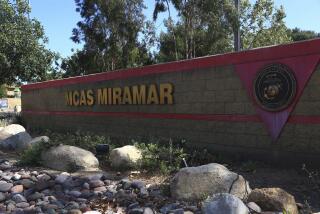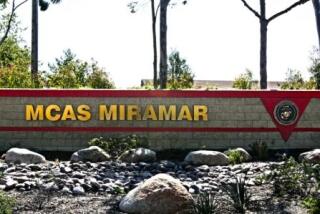Injured Jet Pilot Shows Some Gains
- Share via
The Marine Corps pilot who was pulled from the smoking wreckage of an F/A-18 Hornet jet fighter improved somewhat Monday as military safety experts launched an investigation into why the aircraft crashed while performing a “routine” loop maneuver during a Sunday air show.
Col. Jerry Cadick’s condition was upgraded from critical to serious but stable following surgery earlier in the day at Mission Hospital Regional Medical Center in Mission Viejo.
Friends and family members Monday expressed hope that Cadick, 45, a veteran of 26 years in the Marine Corps, would fully recover from his injuries. A hospital spokesman said Cadick suffered a collapsed lung, internal injuries and multiple fractures.
“We were all there watching when it happened,” said Gena May, the pilot’s mother-in-law. She said the family is thankful that he was not killed. “He’s doing pretty good. That’s about all I can say.”
A Marine spokesman, Maj. Stan Gould, refused to speculate on the cause of the crash, which came before an estimated 300,000 spectators at the Sunday air show when the tail of the F/A-18 bumped the runway as the plane flew close to the ground while completing a wide loop. A Marine spokesman described the maneuver as “a standard routine loop” that Cadick had performed many times before.
Gould said the wreckage of the $23-million plane had been placed in a hangar at El Toro Marine Corps Air Station and was being inspected by a five-member Aircraft Mishap Board.
Investigation of the crash centered on whether Cadick, a seasoned, highly decorated combat pilot, lost control of the plane or whether the crash was caused by mechanical error.
As for Cadick, Marine spokesmen said he was eminently qualified to fly the supersonic fighter and in fact was one of three El Toro pilots specifically designated to fly the F/A-18 Hornet in air show demonstrations.
Cadick had performed the loop maneuver without incident at least three times in the eight days leading up to the crash: in practice runs April 16 and April 21 and again on Friday during a special air show at the base. He also performed the same maneuver in air shows last October and November, a spokesman said.
In addition, Marine spokesmen noted that Cadick served as executive officer of the Fighter/Attack Squadron 125 at a Naval Air Station in Northern California from September, 1982, until May, 1984, a tour of duty that involved training other F/A-18 pilots how to perform maneuvers in air shows and exhibitions.
An Experienced Pilot
“This is a man who flies quite a bit,” said Gould, a public information officer at El Toro. “He is an air show pilot, trained as such. He knows what he’s doing.”
Hinting at possible mechanical problems with the plane, Maj. Gen. Donald E.P. Miller said Sunday that the investigation team would look into whether “the engines had skipped a beat” at a critical point in Cadick’s maneuver.
Tom Williams, a spokesman for McDonnell Douglas Aircraft, makers of the Hornet, said the F/A-18 was specifically designed to perform in such maneuvers and would have been under no unusual stress making a simple loop maneuver such as the one attempted by Cadick.
“The aircraft itself has been described as the best low-speed maneuvering fighter plane of its kind,” Williams said. “The plane is a fighter attack aircraft. Fighter planes are designed to pull tight loops and turns.”
Although Cadick was flying the Hornet when it crashed, another Marine Corps pilot, Capt. R.A. Karwowski, was listed on the air show program as the pilot performing the loop.
Lt. Shawn Cooper said it was a mix-up that Karwowski was listed in the program. She said the program had been printed months in advance and put together while Cadick was on maneuvers in the desert. Karwowski, she said, was one of the other two El Toro pilots designated to perform air show stunts.
When Cadick returned from desert maneuvers, Cooper said it was determined that he would fly in the show instead of Karwowski. Cadick, she noted, is commanding officer of El Toro’s Marine Aircraft Group 11 of the 3rd Marine Aircraft Wing and as such, Karwowski’s commanding officer.
As Cadick was showing some improvement at Mission Hospital, neighbors expressed optimism about the pilot’s recovery.
Dottie Ortiz, who lives near the Cadicks’ San Clemente home high atop a hill overlooking Capistrano Bay, described the Marine as “very personable and friendly.”
“I waved at them yesterday morning before he went off to the air show,” Ortiz said. “I just found out that very day that he was going to be flying. I didn’t know in advance. I’m so glad I didn’t know. I wouldn’t have wanted to see that happen.”
Ortiz said her mother recently underwent open heart surgery and is a patient at the same hospital as Cadick. She said her sister was visiting her mother at the hospital Sunday afternoon and saw Cadick being wheeled in for treatment.
“She didn’t know at the time he was our neighbor,” Ortiz said. “She talked about it when she got home. So right away we started listening to the radio to see if it could have been Jerry.”
“We were so concerned because they’re close neighbors, and we care so much about them. We hope that all goes well,” she said.
Ortiz said the Cadicks have lived on the street for about two years. “We were Jerry’s guests at the air show last year,” she said. “We feel very fond of Jerry. We have a high regard for him as a neighbor and as a pilot and as a Marine Corps officer.
Another neighbor, Yvonne Sibley, said Cadick is a “very nice man” who had befriended her daughters Anna, 4, and Emily, 6.
“When he’s out there, they’re always around him,” Sibley said, adding that Cadick had recently given Emily two gold stickpins in the shape of airplanes.
“(Emily) really loves him very much,” Sibley said. “Unfortunately, we had turned the news on and they said his name. Unfortunately, she saw it. It was a real shock. Her words were, ‘What am I going to do without my best friend?’ ”
More to Read
Sign up for Essential California
The most important California stories and recommendations in your inbox every morning.
You may occasionally receive promotional content from the Los Angeles Times.










